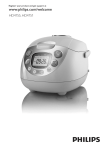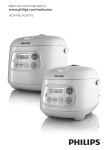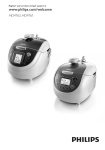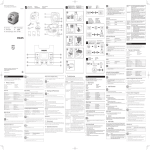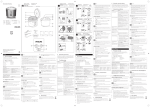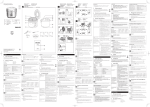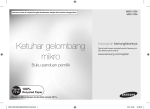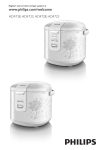Download Philips HD4740 0.4L Rice Cooker
Transcript
HD4740 2 3 1 4 HD4740 English 6 Bahasa Melayu 13 繁體中文 21 简体中文 27 6 English Introduction Congratulations on your purchase and welcome to Philips! To fully benefit from the support that Philips offers, register your product at www.philips.com/welcome. General description (Fig. 1) A Lid B Steam vent C Rice cooker handle D Scoop holder E Heating element F Mains cord G Rice scoop H Measuring cup I Inner pot J Water level indication K Main body L Control panel M Mains cord connection N Detachable steam vent cap O Release lever Important Read this user manual carefully before you use the appliance and save it for future reference. Danger -- Never immerse the housing of the rice cooker in water, nor rinse it under the tap. Warning -- Check if the voltage indicated on the appliance corresponds to the local mains voltage before you connect the appliance. -- Only connect the appliance to an earthed wall socket. Always make sure that the plug is inserted firmly into the wall socket. -- Do not use the appliance if the plug, the mains cord or the appliance itself is damaged. -- If the mains cord is damaged, it must be replaced by Philips, a service centre authorised by Philips or similarly qualified persons in order to avoid a hazard. -- This appliance is not intended for use by persons (including children) with reduced physical, sensory or mental capabilities, or lack of experience and knowledge, unless they have been given supervision or instruction concerning use of the appliance by a person responsible for their safety. -- Children should be supervised to ensure that they do not play with the appliance. -- Keep the mains cord out of the reach of children. Do not let the mains cord hang over the edge of the table or worktop on which the appliance stands. -- Make sure the heating element, the magnetic switch and the outside of the inner pot are clean and dry before you put the plug in the wall socket. -- Do not cover the steam vent and the lid while the rice cooker is operating. -- Do not plug the appliance in or switch on the mains with wet hands. Caution -- Never use any accessories or parts from other manufacturers or that Philips does not specifically recommend. If you use such accessories or parts, your guarantee becomes invalid. -- Only use the rice scoop provided. Avoid using sharp utensils. English 7 -- Do not expose the rice cooker to high temperatures, nor place it on a working or still hot stove or cooker. -- Always insert the inner pot before you put the plug in the wall socket. -- Always unplug the rice cooker and let it cool down before you clean it. -- Do not place the inner pot directly over an open fire to cook rice. -- This appliance is intended to be used in household and similar applications such as: -- staff kitchen areas in shops, offices and other working environments; -- farm houses; -- by clients in hotels, motels and other residential type environments; -- bed and breakfast type environments. -- If the appliance is used improperly or for professional or semi-professional purposes or if it is not used according to the instructions in this user manual, the guarantee becomes invalid and Philips refuses liability for any damage caused. -- Place the rice cooker on a stable, horizontal and level surface. -- The accessible surfaces may become hot when the appliance is in operation. -- Beware of hot steam coming out of the steam vent during cooking or out of the rice cooker when you open the lid. -- Always unplug the appliance after use. -- Do not lift and move the rice cooker by its handles while it is operating. Electromagnetic fields (EMF) This Philips appliance complies with all standards regarding electromagnetic fields (EMF). If handled properly and according to the instructions in this user manual, the appliance is safe to use based on scientific evidence available today. Before first use Remove the sheet between the inner pot and the heating element. 1 Clean the parts of the rice cooker thoroughly before using the appliance for the first time (see chapter ‘Cleaning’). Make sure all parts are completely dry before you start using the appliance. 2 Attach the scoop holder to the body of the rice cooker (Fig. 2). Using the appliance Cooking rice 1 Measure the rice using the measuring cup provided. Each cup of uncooked rice normally gives 2 bowls of cooked rice. Do not exceed the quantities indicated on the inside of the inner pot. 1 cup of rice is approx. 180ml. -- HD4740: 1-3 cups of rice Menu Quantity of rice (cups) Regular rice cooking 1-3 Congee cooking 0.25-0.50 2 Wash the rice thoroughly. Use a separate container to wash the rice to avoid damaging the non-stick coating of the inner pot. 3 Put the pre-washed rice in the inner pot. English 8 4 Add water to the level indicated on the scale inside the inner pot that corresponds to the number of cups of rice used. Then smooth the rice surface. (Fig. 3) For instance, if you cook 2 cups of rice, add water up to the 2-cup level indicated on the scale. Note:The level marked inside the inner pot is just an indication; you can always adjust the water level and your own preference. 5 Press the release lever to open the lid. 6 Put the inner pot in the rice cooker. Check if the inner pot is in proper contact with the heating element (Fig. 4). Make sure that the outside of the inner pot is dry and clean and that there is no foreign residue on the heating element or the magnetic switch. The rice cooker will not operate without the inner pot or when the pot is not properly in contact with the heating element. 7 Close the lid of the rice cooker, put the plug in the wall socket and switch on the mains. You will hear a beep. 8 Press the COOK/QUICK button (Fig. 5). ,, The cook light goes on and the cooking process starts. ,, You can switch to quick cooking within the first 5 minutes of the cooking process by pressing the COOK/QUICK button twice. ,, The display counts down in minutes (10, 9, 8 etc.) during the last 10 minutes of the cooking process. ,, When the cooking process is finished, you will hear a beep. The cook or quick light goes out and the keep-warm/reheat light starts to burn continuously to indicate that the rice cooker has automatically switched to the keep-warm mode (Fig. 6). The table below shows the approximate cooking time of each function. The actual cooking time may vary depending on voltage, room temperature, humidity and amount of water used. Function Approximate cooking time (minutes) Approximate time until ready (minutes) Regular 30-40 10 Quick 20-30 10 Congee 30-240 not applicable Reheat 23 20 9 Open the lid and stir the rice to loosen it (Fig. 7). For the best results, do this just after the rice cooker has switched to keep-warm mode. Then close the lid firmly. Stirring the rice allows excess steam to escape. This will give fluffier rice. 10Press the OFF button to cancel the cooking process, the preset setting or the keep-warm mode. The cook light will start to blink (Fig. 8). The rice cooker has a backup memory that retains the last selected mode, function and settings in case of a power failure. If the power supply is restored within 2 hours, the interrupted cooking process will continue or the timer function will be reactivated. Always press the OFF button before unplugging the appliance, as otherwise the last selected function and settings will resume when the rice cooker is plugged in again. 11Unplug the rice cooker to switch it off. English 9 Cooking congee 1 Follow steps 1 to 7 in ‘Cooking rice’. Do not exceed the volume indicated in the table for congee cooking, as this may cause the rice cooker to overflow. 2 Press the CONGEE button (Fig. 9). The congee light goes on. The default cooking time of 1 hour blinks on the display. ,, Press the HR and/or MIN buttons to set the desired time.You can set any time between 30 minutes and 4 hours (Fig. 10). ,, If you fail to set a cooking time, the default cooking time of 1 hour will apply. ,, The congee cooking process automatically starts within 5 seconds of setting the cooking time. When the cooking process starts, the display switches from preset time to current time. To view the preset cooking time, press the HR or MIN button once. ,, When the cooking process is finished, you will hear a beep. The congee light goes out and the keep-warm/reheat light starts to burn continuously to indicate that the rice cooker has automatically switched to the keep-warm mode. 3 Press the OFF button to cancel the cooking process, the preset setting or the keep-warm mode. The cook light will start to blink. 4 Unplug the rice cooker to switch it off. Reheating You can use the reheating mode to warm up rice that has cooled down. Fill the inner pot to not more than half its capacity to ensure that the rice is heated up properly. 1 Loosen the cooled rice and evenly distribute it in the inner pot. 2 Pour some water onto the rice to prevent it from becoming too dry. The amount of water to be added depends on the amount of rice being reheated. If the rice starts scorching, add more water. 3 Press the KEEP-WARM/REHEAT button twice to start the reheating process. ,, The keep-warm/reheat light starts to blink and the reheating process starts. ,, The reheat time is displayed and the countdown starts. ,, The default reheat time is 9 minutes. ,, When the reheating process is finished, you will hear a beep. The keep-warm/reheat light starts to burn continuously to indicate that the rice cooker has automatically switched to keep-warm mode. ,, Mix the rice thoroughly before serving. ,, Cooled rice should not be reheated more than once. Keeping warm This function allows you to keep your rice warm for a longer period of time. Press the KEEP-WARM/REHEAT button once to start the keep-warm function. Note:The keep-warm/reheat light starts to burn continuously. We advise you to keep rice warm for not more than 12 hours so as to preserve its taste. During the keep-warm process, the display shows the time in hours from 0 to 11 (0HR, 1HR ...11HR). After 12 hours, the display will switch to the current time. After 12 hours, the keep-warm mode will end and the cook light will blink. Press the OFF button and remove the plug from the wall socket to switch the rice cooker off. 10 English Timer You can use the timer for rice cooking and congee cooking. Press the TIMER button to set the time when you want the food to be ready to eat. You can set a time from 0 minutes up to 23 hours. Setting the ready time of rice: 1 To set the rice ready time, press the TIMER button once and then use the HR and/or MIN buttons to set the time. ,, You can for example use the TIMER button to set the rice ready time at 6:30 PM (Fig. 11). 2 Press the COOK/QUICK button to start the timer and the cooking process. (Fig. 12) The cook light blinks and the timer light burns continuously. The display shows the current time. To view the preset time, press the HR or MIN button once. If the preset time is shorter than the required total cooking time, the rice cooker will start the cooking process immediately. Setting the ready time of congee: 1 To set the congee ready time, press the TIMER button once and then use the HR and or MIN buttons to set the time. (Fig. 13) ,, You can for example use the TIMER button to set the congee ready time at 6:30 PM. 2 Press the CONGEE button then follow step 2 in the section ‘Cooking congee’. The congee light blinks and the timer light burns continuously. The display shows the current time. To view the preset time, press the HR or MIN button once. If the preset time is shorter than the required total cooking time, the rice cooker will start the cooking process immediately. Clock To set the current time: 1 Plug in the rice cooker. 2 Press the Ö button once and then use the HR and MIN buttons to set the time. ,, The time on the display starts to blink. ,, You can put the time forward quickly by holding down the HR or MIN button. ,, The time cannot be adjusted during the cooking or the keep-warm process. 3 To confirm the time, do not press any key for 5 seconds after setting the time. The time has been confirmed when the time indicated on the display stops blinking. Cleaning Unplug the rice cooker before starting to clean it. Wait until the rice cooker has cooled down sufficiently before cleaning it. To protect the non-stick coating of the inner pot, do not: -- use the inner pot for washing dishes; -- put vinegar into the pot. 1 Take the inner pot out of the body of the appliance. 2 Detach the steam vent cap from the lid by pulling it upwards (Fig. 14). ,, To take the steam vent cap apart, gently pull the two halves apart (Fig. 15). ,, To reassemble the steam vent cap, align the dots on the top and bottom half and then push the two halves together (‘click’). English 11 ,, To put the steam vent cap back into the vent hole of the lid, insert it into the hole and push it down firmly (Fig. 16). 3 Clean the inner pot, rice scoop and steam vent cap with a sponge or a cloth in hot water with some washing-up liquid. Do not use abrasive cleaning agents, scourers or metal utensils to clean the inner pot as these will damage the non-stick coating. 4 Use only a damp cloth to wipe the outside and inside of the body and the lid of the rice cooker. Never immerse the body of the rice cooker in water, nor rinse it under the tap. Wipe the heating element with a dry cloth. Environment -- Do not throw away the appliance with the normal household waste at the end of its life, but hand it in at an official collection point for recycling. By doing this, you help to preserve the environment (Fig. 17). Guarantee & service If you need service or information or if you have a problem, please visit the Philips website at www.philips.com or contact the Philips Consumer Care Centre in your country (you find its phone number in the worldwide guarantee leaflet). If there is no Consumer Care Centre in your country, go to your local Philips dealer. Troubleshooting If your rice cooker does not function properly or if the cooking quality is insufficient, consult the table below. If you are unable to solve the problem, please contact the Philips Customer Care Centre in your country. Problem Cause Solution The cook light or congee light does not go on. There is a connection problem. Check if the rice cooker is connected to the mains and if the plug is inserted firmly into the wall socket. The light is defective. Take the appliance to your Philips dealer or a service centre authorised by Philips. The keep-warm/ reheat light does not go on when the cooking process is finished. The light is defective. Take the appliance to your Philips dealer or a service centre authorised by Philips. LCD shows E0,E1,E2,E3,E4 Electronic parts malfunction. Take the appliance to your Philips dealer or a service centre authorised by Philips. LCD shows E5 Press OFF button once. The appliance will resume normal. 12 English Problem Cause Solution The display is off when the rice cooker is unplugged. The battery runs out. Take the appliance to your Philips dealer or a service centre authorised by Philips. Water spills out of Too much water was the appliance used for cooking rice. during rice cooking. Make sure that you add water to the level indicated on the scale inside the inner pot that corresponds to the number of cups of rice used. Make sure the water does not exceed the next level on the scale as this may cause overflow during cooking. The rice is not cooked. Not enough water has been added. Add water according to the scale on the inside of the inner pot (see chapter ‘Using the appliance’). The cooking process has not started. You have failed to press the COOK or CONGEE button. The inner pot is not properly in contact with the heating element. Make sure that there is no foreign residue on the heating element. The heating element is damaged. Take the appliance to your Philips dealer or a service centre authorised by Philips. The timer light does not go on when the timer is set. The light is defective. Take the appliance to your Philips dealer or a service centre authorised by Philips. The rice is cooked too hard. Not enough water was used for cooking rice. Add slightly more water to the level indicated on the cale inside the inner pot that corresponds to the number of cups of rice used. Make sure the water does not exceed the next level on the scale as this may cause overflow during cooking. The wrong button was See chapter ‘Using the appliance’. pressed. The rice is cooked too soft. Too much water was used for cooking rice. Make sure you add water according to the scale on the inside of the inner pot (see chapter ‘Using the appliance’). The wrong button was See chapter ‘Using the appliance’. pressed. The rice is scorched. The rice has not been rinsed well. Rinse the rice until water runs clear. The rice cooker does not automatically switch to keepwarm mode. The temperature control is defective. Take the appliance to your Philips dealer or a service centre authorised by Philips. Bahasa Melayu 13 Pengenalan Tahniah atas pembelian anda, dan selamat datang ke Philips! Untuk mendapat manfaat sepenuhnya daripada sokongan yang ditawarkan oleh Philips, daftarkan produk anda di www.philips.com/ welcome. Perihalan umum (Gamb. 1) A Tudung B Bolong stim C Pemegang pemasak nasi D Pemegang senduk E Elemen pemanasan F Kord sesalur kuasa G Senduk nasi H Cawan penyukat I Periuk dalam J Penunjuk paras air K Jasad utama L Panel kawalan M Sambungan kord utama N Tukup bolong stim boleh tanggal O Tuil pelepas Penting Baca manual pengguna ini dengan teliti sebelum anda menggunakan perkakas dan simpan untuk rujukan masa depan. Bahaya -- Jangan tenggelamkan perumah pemasak nasi di dalam air atau membilasnya di bawah pili air. Amaran: -- Periksa sama ada voltan yang ditunjukkan pada perkakas sepadan dengan voltan sesalur kuasa setempat sebelum anda menyambungkan perkakas. -- Sambungkan perkakas hanya kepada soket dinding terbumi. Sentiasa pastikan plag dimasukkan dengan rapi ke dalam soket. -- Jangan gunakan perkakas jika plag, kord sesalur kuasa atau perkakas itu sendiri rosak. -- Jika sesalur kuasa rosak, ia mesti digantikan oleh Philips, pusat servis yang dibenarkan oleh Philips atau pihak-pihak yang telah diluluskan bagi mengelakkan bahaya. -- Perkakas ini tidak dimaksudkan untuk digunakan oleh orang (termasuk kanak-kanak) yang kurang upaya dari segi fizikal, deria atau mental, atau kurang berpengalaman dan pengetahuan, kecuali mereka diawasi atau diberi arahan berkenaan penggunaan perkakas ini oleh orang yang bertanggungjawab atas keselamatan mereka. -- Kanak-kanak hendaklah diselia untuk memastikan mereka tidak bermain dengan perkakas ini. -- Jauhkan kord sesalur kuasa dari capaian kanak-kanak. Jangan biarkan kord sesalur kuasa tergantung melepasi pinggir meja atau permukaan tempat kerja di mana perkakas berada. -- Pastikan elemen pemanasan, suis magnet dan bahagian luar periuk dalam bersih dan kering sebelum anda memasukkan plag ke dalam soket dinding. -- Jangan tutup bolong stim semasa periuk pemasak nasi sedang beroperasi. -- Jangan pasang plag perkakas atau hidupkan sesalur kuasa dengan tangan yang basah. Awas -- Jangan sekali-kali menggunakan sebarang aksesori atau bahagian daripada pengilang lain atau yang tidak disyorkan secara khusus oleh Philips. Jika anda menggunakan aksesori atau bahagian sedemikian, jaminan anda menjadi tidak sah. 14 Bahasa Melayu -- Gunakan hanya senduk nasi yang disediakan. Elakkan menggunakan perkakas yang tajam. -- Jangan dedahkan pemasak nasi pada suhu yang tinggi, atau letakkannya di atas pemanas atau dapur yang sedang berfungsi atau masih panas. -- Sentiasa masukkan periuk dalam sebelum anda memasukkan plag ke dalam soket dinding. -- Sentiasa cabutkan plag pemasak nasi dan biarkan sehingga sejuk sebelum anda membersihkannya. -- Jangan letakkan periuk dalam terus di atas api terbuka untuk memasak nasi. -- Perkakas ini dimaksudkan untuk digunakan dalam rumah dan penggunaan yang serupa seperti: -- kawasan dapur kakitangan di kedai, pejabat dan persekitaran kerja; -- kediaman di ladang; -- oleh klien di hotel, motel dan persekitaran penginapan yang lain; -- persekitaran jenis inap-sarapan. -- Jika perkakas digunakan dengan cara yang tidak betul, atau untuk tujuan profesional atau separa profesional, atau jika ia tidak digunakan mengikut arahan dalam panduan pengguna ini, jaminan menjadi tidak sah dan Philips menolak sebarang liabiliti terhadap sebarang kerosakan yang berlaku. -- Letakkan periuk pemasak nasi pada permukaan yang stabil, mendatar dan rata. -- Permukaan yang dapat dicapai mungkin menjadi panas apabila perkakas beroperasi. -- Berhati-hati dengan stim panas yang keluar dari bolong stim semasa memasak atau yang keluar dari periuk pemasak nasi semasa anda membuka tudungnya. -- Cabutkan plag perkakas setiap kali selepas digunakan. -- Jangan angkat dan pindahkan periuk pemasak nasi dengan pemegangnya semasa ia sedang beroperasi. Medan Elektro Magnet (EMF) Perkakas Philips ini mematuhi semua piawai yang berhubung dengan medan elektromagnet (EMF). Jika dikendalikan dengan betul dan mematuhi arahan dalam manual pengguna ini, perkakas selamat untuk digunakan menurut bukti saintifik yang boleh didapati pada masa ini. Sebelum penggunaan pertama Keluarkan alas di antara periuk dalam dan plat pemanas. 1 Bersihkan bahagian berasingan periuk pemasak nasi dengan sempurna sebelum menggunakan perkakas pada kali pertama (lihat bab ‘Membersihkan’). Pastikan semua bahagiannya betulbetul kering sebelum anda mula menggunakan perkakas. 2 Pasangkan pemegang senduk pada jasad utama periuk pemasak nasi (Gamb. 2). Menggunakan perkakas Memasak nasi 1 Ukur beras menggunakan cawan penyukat yang disediakan. Setiap cawan beras biasanya memberikan 2 mangkuk nasi. Jangan lebihi kuantiti yang ditunjukkan pada permukaan dalam periuk dalam. 1cawan nasi adalah kira-kira 180ml. -- HD4740: 1-3 cawan beras Menu Kuantiti beras (cawan) Memasak nasi biasa 1-3 Pemasakan bubur 0.25-0.50 2 Basuh beras dengan sempurna. Gunakan bekas lain untuk membasuh beras supaya salutan tidak lekat pada periuk dalam tidak rosak. Bahasa Melayu 15 3 Tuangkan beras yang sudah dibasuh ke dalam periuk dalam. 4 Tambahkan air sehingga aras yang ditunjukkan pada skala di dalam periuk, yang sepadan dengan bilangan cawan beras yang digunakan. Kemudian ratakan permukaan beras. (Gamb. 3) Contohnya, jika anda memasak 2 cawan beras, tambahkan air sehingga aras 2 cawan yang ditunjukkan pada skala. Nota: Aras yang ditandakan di dalam periuk dalam hanyalah panduan; anda boleh melaraskan aras air dan kegemaran anda sendiri. 5 Tekan butang pelepas untuk membuka tudungnya. 6 Masukkan periuk dalam ke dalam periuk pemasak nasi. Periksa sama ada periuk dalam dan plat pemanas besentuhan dengan baik pada satu sama lain (Gamb. 4). Pastikan bahagian luar periuk dalam adalah kering dan bersih, dan tiada sisa asing pada plat pemanas atau suis magnet. Pemasak masi tidak akan beroperasi tanpa periuk dalam atau apabila periuk tidak bersentuhan dengan elemen pemanasan dengan betul. 7 Tutup tudung periuk pemasak nasi, pasangkan plag di dalam soket dinding dan hidupkan sesalur kuasa. Anda akan terdengar bunyi klik. 8 Tekan butang COOK/QUICK (Gamb. 5). ,, Lampu masak menyala dan proses masak bermula. ,, Anda boleh beralih kepada masakan cepat dalam masa 5 minit yang pertama daripada proses memasak dengan menekan butang COOK/QUICK dua kali. ,, Paparan mengira detik dalam minit (10, 9, 8 dsb.) semasa 10 minit terakhir proses memasak. ,, Apabila proses memasak telah selesai, anda akan mendengar bip. Lampu masak atau lampu cepat akan padam dan lampu simpan panas/panas semula akan menyala untuk menunjukkan bahawa periuk pemasak nasi telah beralih ke mod simpan panas secara automatik (Gamb. 6). Jadual di bawah menunjukkan anggaran masa memasak bagi setiap fungsi. Masa memasak sebenar berbeza-beza bergantung pada voltan, suhu bilik, kelembapan dan jumlah air yang digunakan. Fungsi Anggaran masa memasak (minit) Anggaran masa sehingga siap (minit) Biasa 30-40 10 Cepat 20-30 10 Bubur nasi 30-240 tidak berkaitan Panaskan semula 23 20 9 Buka tudung dan kacau nasi agar rata (Gamb. 7). Untuk hasil terbaik, lakukan sebaik saja periuk pemasak nasi beralih ke mod simpan panas. Kemudian tutup tudung dengan rapi. Mengacau nasi membolehkan stim keluar. Ini akan menjadikan nasi lebih lembut. 10Tekan butang OFF untuk membatalkan proses memasak, tetapan pratetap atau mod simpan panas. Lampu masak akan mula berkelip (Gamb. 8). Periuk pemasak nasi mempunyai memori sandaran yang menyimpan mod, fungsi dan tetapan yang terakhir dipilih jika berlaku gangguan bekalan kuasa. Jika bekalan kuasa dipulihkan dalam masa 2 jam, proses memasak yang telah diganggu akan diteruskan atau fungsi pemasa akan diaktifkan semula. 16 Bahasa Melayu Sentiasa tekan butang OFF sebelum anda mencabut plag perkakas, jika tidak mod, fungsi dan tetapan yang terakhir dipilih akan disambung semula apabila plag periuk pemasak nasi dipasang semula. 11Cabut plag periuk pemasak nasi untuk mematikkannya. Memasak bubur nasi 1 Ikut langkah 1 hingga 7 dalam bahagian ‘Memasak nasi’. Jangan melebihi isipadu yang ditunjukkan dalam jadual untuk memasak bubur nasi, kerana ini boleh menyebabkan periuk pemasak nasi membuak. 2 Tekan butang CONGEE (Gamb. 9). Lampu bubur nasi menyala. Masa memasak lalai selama 1 jam berkelip pada paparan. ,, Tekan butang HR dan/atau MIN untuk menetapkan masa yang dikehendaki. Anda boleh menetapkan sebarang masa antara 30 minit dan 4 jam (Gamb. 10). ,, Jika anda gagal untuk menetapkan masa memasak, masa memasak lalai selama 1 jam akan digunakan. ,, Proses memasak bubur bermula secara automatik dalam masa 5 saat setelah menetapkan masa memasak. Apabila proses memasak bermula, paparan akan menukar masa yang dipratetap kepada masa semasa. Untuk melihat masa memasak pratetap, tekan butang HR atau MIN sekali. ,, Apabila proses memasak telah selesai, anda akan mendengar bip. Lampu bubur akan padam dan lampu simpan panas/panas semula akan menyala untuk menunjukkan bahawa periuk pemasak nasi telah beralih ke mod simpan panas secara automatik. 3 Tekan butang OFF untuk membatalkan proses memasak, tetapan pratetap atau mod simpan panas. Lampu masak akan mula berkelip. 4 Cabut plag periuk pemasak nasi untuk mematikkannya. Panas semula Anda boleh mengunakan mod panas semula untuk menghangatkan nasi yang telah sejuk. Isi periuk dalam tidak lebih daripada separuh kapasitinya untuk memastikan nasi dipanaskan dengan betul. 1 Kacau nasi sejuk dan ratakannya di dalam periuk dalam. 2 Tuang sedikit air pada nasi untuk mengelakkannya daripada terlalu kering. Jumlah air untuk ditambah bergantung pada jumlah nai yang sedang dipanaskan. Jika nasi mula menjadi panas, tambahkan sedikit lagi air. 3 Tekan butang KEEP-WARM/REHEAT dua kali untuk memulakan proses memanaskan semula. ,, Lampu keep-warm/reheat mula berkelip dan proses memanaskan semula bermula. ,, Masa pemanasan semula dipaparkan dan pengiraan detik bermula. ,, Masa memanaskan lalai adalah 9 minit. ,, Apabila proses memanaskan semula selesai, anda akan mendengar bunyi bip. Lampu simpan panas/panas semula menyala berterusan menunjukkan bahawa periuk pemasak nasi telah menukar secara automatik ke mod simpan panas. ,, Ratakan nasi sebelum dihidangkan. ,, Nasi yang sejuk tidak seharusnya dipanaskan lebih daripada sekali. Menyimpan panas Fungsi ini membolehkan anda menyimpan panas nasi anda untuk tempoh yang lebih panjang. Tekan butang KEEP-WARM/REHEAT sekali untuk memulakan fungsi simpan panas. Nota: Lampu simpan panas/panas semula menyala berterusan. Bahasa Melayu 17 Anda dinasihati agar menghangatkan nasi tidak lebih daripada 12 jam untuk mengekalkan rasanya. Semasa proses simpan panas, paparan menunjukkan masa dalam jam daripada 0 hingga 11 (0HR, 1HR ...11HR). Selepas 12 jam, paparan akan bertukar ke masa semasa. Selepas 12 jam, mod simpan panas akan tamat dan lampu masak akan berkelip. Tekan butang OFF dan tanggalkan plag dari soket dinding untuk mematikan periuk pemasak nasi. Pemasa Anda boleh menggunakan pemasa untuk memasak nasi dan memasak bubur. Tekan butang PEMASA untuk menetapkan masa yang anda hendak makanan itu siap untuk dimakan. Anda boleh menetapkan masa daripada 0 minit sehingga 23 jam. Menetapkan masa siap nasi: 1 Untuk menetapkan masa siap nasi, tekan butang PEMASA sekali dan kemudian guanakan butang HR dan/atau MIN untuk menetapkan masanya. ,, Anda boleh, contohnya, menggunakan butang TIMER untuk menetapkan masa siap nasi pada pukul 6:30 PM (Gamb. 11). 2 Tekan butang COOK/QUICK untuk memulakan pemasa dan proses memasak. (Gamb. 12) Lampu masak berkelip dan lampu pemasa menyala berterusan. Paparan menunjukkan masa sekarang. Untuk melihat masa yang dipratetapkan, tekan butang HR atau MIN sekali. Jika masa pratetap lebih singkat daripada jumlah masa memasak yang diperlukan, periuk pemasak nasi akan memulakan proses memasak dengan segera. Menetapkan masa siap bubur: 1 Untuk menetapkan masa siap bubur, tekan butang TIMER sekali dan kemudian gunakan butang HR dan atau MIN untuk menetapkan masa. (Gamb. 13) ,, Anda boleh, contohnya, menggunakan butang TIMER untuk menetapkan masa siap bubur pada pukul 6:30 PM. 2 Tekan butang CONGEE kemudian ikut langkah 2 dalam bahagian ‘Memasak bubur’. Lampu bubur berkelip dan lampu pemasa menyala berterusan. Paparan menunjukkan masa sekarang. Untuk melihat masa yang dipratetapkan, tekan butang HR atau MIN sekali. Jika masa pratetap lebih singkat daripada jumlah masa memasak yang diperlukan, periuk pemasak nasi akan memulakan proses memasak dengan segera. Jam Untuk menetapkan masa semasa: 1 Pasang plag ke dalam periuk pemasak nasi. 2 Tekan Ö butang sekali dan kemudian gunakan butang HR dan MIN untuk menetapkan masa. ,, Masa pada paparan mula berkelip. ,, Anda boleh mempercepatkan masa dengan menekan dan menahan butang HR atau MIN. ,, Masa tidak boleh dilaraskan semasa proses memasak atau menyimpan panas. 3 Untuk mengesahkan masa, jangan tekan sebarang kekunci selama 5 saat selepas menetapkan masa. Masa telah disahkan apabila masa yang ditunjukkan pada paparan berhenti berkelip. Pembersihan Cabutkan plag perkakas setiap kali sebelum anda mula membersihkannya. Tunggu sehingga periuk pemasak nasi telah sejuk secukupnya sebelum membersihkannya. Untuk melindungi salutan tidak lekat pada periuk, jangan: -- gunakan periuk dalam untuk membasuh pinggan; -- tuangkan cuka ke dalam periuk. 18 Bahasa Melayu 1 Keluarkan periuk dalam daripada jasad perkakas. 2 Tanggalkan tukup bolong stim daripada tudung dengan menariknya ke atas (Gamb. 14). ,, Untuk membuka tukup bolong stim, tarik kedua-dua bahagian dengan perlahanlahan (Gamb. 15). ,, Untuk memasang semula tukup bolong stim, jajarkan titik pada bahagian atas dan bawah dan kemudian tolak kedua-dua bahagian sekali (‘klik’). ,, Untuk mengembalikan tukup bolong stim ke dalam lubang bolong pada tudung, masukkannya ke dalam lubang dan tekannya ke bawah dengan kukuh (Gamb. 16). 3 Bersihkan periuk dalam, senduk nasi dan tukup bolong stim dengan span atau kain di dalam air panas dengan sedikit cecair pencuci. Jangan gunakan agen pembersih yang melelas, kain penyental atau alatan logam untuk membersihkan periuk dalam kerana ini akan merosakkan salutan tidak lekat. 4 Gunakan hanya kain yang lembap untuk mengesat permukaan luar dan dalam jasad dan tudung periuk pemasak nasi. Jangan sekali-kali tenggelamkan jasad periuk pemasak nasi di dalam air, atau membilasnya di bawah pili air. Kesat plat pemanas dengan kain kering. Alam sekitar -- Jangan buang perkakas ke dalam tong sampah rumah apabila sampai akhir hayatnya, tetapi bawanya ke pusat pungutan rasmi untuk dikitar semula. Dengan melakukan sedemikian anda akan membantu memelihara alam sekitar (Gamb. 17). Jaminan dan servis Jika anda memerlukan perkhidmatan atau maklumat atau jika anda mengalami masalah, sila lawati tapak web Philips di www.philips.com atau hubungi Pusat Layanan pelanggan Philips di negara anda (anda boleh mendapatkan nombor telefonnya di dalam risalah jaminan sedunia). Jika tiada Pusat Layanan Pelanggan di negara anda, hubungi wakil pengedar Philips tempatan. Menyelesaikan masalah Jika periuk pemasak nasi tidak berfungsi dengan betul atau jika mutu masakan tidak baik, rujuk jadual di bawah. Jika anda tidak dapat menyelesaikan masalahnya, sila hubungi Pusat Penjagaan Pelanggan Philips di negara anda. Masalah Sebab Penyelesaian Lampu masak atau lampu bubur tidak menyala. Terdapat masalah sambungan. Periksa sama ada periuk pemasak nasi bersambung dengan sesalur dan sama ada plag dimasukkan dengan rapi ke dalam soket dinding. Lampu rosak. Bawa perkakas ke penjual Philips anda atau pusat servis yang disahkan oleh Philips. Lampu rosak. Bawa perkakas ke penjual Philips anda atau pusat servis yang disahkan oleh Philips. Lampu simpan panas/ panas semula tidak menyala apabila proses memasak selesai. Bahasa Melayu 19 Masalah Sebab Penyelesaian LCD menunjukkan E0,E1,E2,E3,E4 Malfungsi bahagianbahagian elekronik. Bawa perkakas ke penjual Philips anda atau pusat servis yang disahkan oleh Philips. LCD menunjukkan E5 Tekan butang OFF sekali. Perkakas akan menyambung semula seperti biasa. Paparan akan padam apabila periuk pemasak nasi dicabut plagnya. Bateri kehabisan kuasa Bawa perkakas ke penjual Philips anda atau pusat servis yang disahkan oleh Philips. Air melimpah keluar daripada perkakas semasa nasi dimasak. Terlalu banyak air digunakan untuk memasak nasi. Pastikan anda mengisi air ke paras yang ditandakan pada skala di bahagian dalam periuk dalaman yang sepadan dengan bilangan cawan beras yang digunakan. Pastikan air itu tidak melebihi paras seterusnya pada skala itu, kerana ini mungkin menyebabkan air melimpah keluar semasa nasi dimasak. Nasi masih mentah. Air yang dimasukkan tidak mencukupi. Tambahkan air mengikut skala di dalam periuk dalam (lihat bab ‘Menggunakan perkakas’). Proses memasak belum lagi bermula. Anda tidak menekan butang COOK atau CONGEE. Periuk dalam dan plat pemanas tidak bersentuhan dengan baik pada satu sama lain. Pastikan tiada sisa asing pada plat pemanas. Plat pemanas rosak. Bawa perkakas ke penjual Philips anda atau pusat servis yang disahkan oleh Philips. Lampu pemasa tidak padam apabila pemasa ditetapkan. Lampu rosak. Bawa perkakas ke penjual Philips anda atau pusat servis yang disahkan oleh Philips. Nasi yang dimasak terlalu keras. Tidak cukup air digunakan untuk memasak nasi. Masukkan sedikit lagi air hingga ke paras yang ditandakan pada skala di bahagian dalam periuk dalaman yang sepadan dengan bilangan cawan beras yang digunakan. Pastikan air itu tidak melebihi paras seterusnya pada skala itu, kerana ini mungkin menyebabkan air melimpah keluar semasa nasi dimasak. Butang yang salah telah ditekan. Lihat bab ‘Menggunakan perkakas’. Terlalu banyak air digunakan untuk memasak nasi. Pastikan anda memasukkan air mengikut skala di bahagian dalam periuk dalaman (lihat bab ‘Menggunakan perkakas’). Butang yang salah telah ditekan. Lihat bab ‘Menggunakan perkakas’. Nasi yang dimasak terlalu lembik. 20 Bahasa Melayu Masalah Sebab Penyelesaian Nasinya hangus. Beras tidak dibasuh dengan betul. Basuh beras sehingga air yang mengalir bersih. Kawalan suhu rosak. Bawa perkakas ke penjual Philips anda atau pusat Periuk pemasak nasi servis yang disahkan oleh Philips. tidak secara automatik beralih ke mod simpan panas.. 繁體中文 21 簡介 恭喜您購買本產品並歡迎加入飛利浦!請於 www.philips.com/welcome 註冊您的產品, 以善用飛利浦提供的支援。 一般說明 (圖 1) A 蓋子 B 蒸氣通氣孔 C 電子鍋握柄 D 飯匙固定座 E 加熱板 F 電源線 G 飯勺 H 量杯 I 內鍋 J 水位刻度 K 主機體 L 控制面板 M 電線連接處 N 可拆式蒸氣通氣孔蓋 O 釋放控制桿 重要事項 在使用本產品前,請先仔細閱讀本使用手冊,並保留說明以供日後參考。 危險 -- 不可將電子鍋浸泡在水中或者在水龍頭下沖洗。 警示 -- 在您連接電源之前,請檢查本地的電源電壓是否與產品所標示的電壓相符。 -- 僅可將本產品連接到有接地的電源插座上。並請務必確定將插頭確實插入電源插座 中。 -- 當插頭、電線或產品本身受損時,請勿使用產品。 -- 如果電源線損壞,必須交由飛利浦、飛利浦授權之服務中心,或是具備相同資格的技 師更換,以免發生危險。 -- 基於安全考慮,在缺乏監督及適當指示之下,本產品不適用於孩童及任何身體、知 覺、或心理功能障礙者,或缺乏使用經驗及知識者。 -- 請勿讓孩童使用本產品或當成玩具。 -- 請勿讓兒童接觸電源線。請勿讓電源線懸掛在產品放置的餐桌或流理台邊緣。 -- 請確定加熱板、磁簧開關與內鍋外側是否清潔、乾燥,再將插頭插入電源插座。 -- 使用電子鍋時,請勿擋住蒸氣通氣孔及鍋蓋。 -- 為電器插上或開啟電源時,請確保雙手未潮濕。 警告 -- 請勿使用其他製造商的任何配件或零件,或非飛利浦建議之配件或零件。如果您使用 此類配件或零件,保修即會失效。 -- 請僅使用隨附的飯匙。請勿使用尖銳的器具。 -- 請勿將電子鍋暴露在高溫下,也請勿放置正在使用 (或尚有餘溫) 的爐子或廚具上。 -- 將插頭插入牆壁的插座之前,請務必先裝入內鍋。 -- 在進行清潔之前,請務必先拔除電子鍋的電源插頭並讓它冷卻下來。 -- 請勿直接將內鍋置於爐火上炊飯。 -- 本產品為居家用途設計,而類似的應用包含: -- 店家的員工廚房、辦公室與其他工作場所; -- 農舍; 22 繁體中文 -- 供住宿的飯店、汽車旅館與其他居住場所; -- 擺設床位與供應早餐的空間。 -- 如果不當使用本產品、作為 (半) 專業用途,或未依照使用手冊操作,保固將無效,且 飛利浦將不擔負任何損壞賠償責任。 -- 請將電子鍋放置在平穩的水平面上。 -- 本產品使用時,暴露在外的表面可能會變熱。 -- 在炊飯過程中,熱氣可能會從蒸氣通氣孔冒出;若您掀開鍋蓋,熱氣可能會從電子鍋 冒出。 -- 用完本產品後,請務必將插頭拔掉。 -- 請勿在使用電子鍋時,以握柄舉起或移動電子鍋。 電磁波 (EMF) 本飛利浦產品符合電磁波 (Electromagnetic fields,EMF) 所有相關標準。只要使用方式正 確並依照本使用手冊之說明進行操作,根據現有的科學研究資料,使用本產品並無安全顧 慮。 第一次使用前 請移除內鍋和加熱板中間的紙張。 1在首次使用本電器前,請徹底清洗電子鍋的各個組件 (請參閱「清潔」章節)。在您開 始使用本電器之前,請確定所有零件都完全乾燥。 2請將飯匙固定座吸附在電子鍋的主機體上。 (圖 2) 使用此產品 炊飯 1使用所附的量杯來量米。 一杯生米通常可煮成 2 碗白飯。請不要超過內鍋內側標示的量線。1 杯米約 180 毫升。 -- HD4740:1-3 杯米 功能表 生米數量 (杯) 烹煮一般米飯 1-3 稀飯 0.25-0.50 2將米徹底洗淨。 請使用另一個容器來洗米以免損壞內鍋的不沾鍋塗層。 3將洗好的米倒入內鍋中。 4在內鍋中加水直到水位刻度相當於所使用的米杯數。然後撫平米粒的表面。 (圖 3) 例如,如果您要煮 2 杯米,請將水加到 2 杯的水位刻度。 注意: 內鍋內側所標示的水位僅供參考;您可以隨時針對您自己的偏好來調整水量。 5按下釋放控制桿,打開鍋蓋。 6將內鍋放入電子鍋中。檢查內鍋是否與加熱板正確接觸。 (圖 4) 請確定內鍋外側是否乾燥、清潔,且沒有異物殘留在加熱板或磁簧開關上。 沒有裝入內鍋之前,或是當內鍋與加熱板接觸不良時,電子鍋均無法啟動。 7關上電子鍋鍋蓋,將插頭插入牆面的插座,再開啟電源。 您會聽到一次嗶聲。 繁體中文 23 8按烹調/快速 (COOK/QUICK) 按鈕。 (圖 5) ,, 烹調指示燈亮起,表示烹調程序開始。 ,, 您可以按兩下烹調/快速 (COOK/QUICK) 按鈕,在烹調程序開始後的 5 分鐘內切換至 快速烹調模式。 ,, 顯示幕會於烹調程序的最後 10 分鐘,以分鐘為單位倒數計時 (10、9、8 等)。 ,, 當烹調程序結束時,您會聽到一次嗶聲。烹調或快速指示燈會熄滅,保溫/再加熱指示 燈開始持續亮著,表示電子鍋已自動切換為保溫模式。 (圖 6) 下表所示為各功能的大約烹調時間。實際烹調時間可能按照電壓、室溫、溼度和所用水量 而不同。 功能 約略烹調時間 (分鐘) 約略完成時間 (分鐘) 一般 30-40 10 快速 20-30 10 粥 30-240 不適用 再加熱 23 20 9開啟鍋蓋,略微攪動,使米飯鬆開。 (圖 7) 為了達到最佳烹調效果,請在電子鍋切換為保溫模式後立即進行此動作。然後關緊鍋蓋。 攪動米飯放出更多蒸氣,讓米飯更為鬆軟。 10 按下關閉 (OFF) 按鈕可取消烹調程序、預設設定或保溫模式。烹調指示燈會開始閃 爍。 (圖 8) 本電子鍋設置有備用記憶功能,萬一遇到停電,可保留最後選取的模式、功能與設定。若 電力在 2 小時內恢復供電,中斷的烹調程序將會繼續,或是重新啟動定時功能。 拔除電子鍋的電源插頭之前,請務必先按下關閉 (OFF) 按鈕,否則當電子鍋再度插上電源 時,會恢復上次選取的功能及設定。 11 請拔下電子鍋電源插頭,以關閉電源。 煮稀飯 1請依照「煮飯」章節的第 1 步到第 7 步操作。 請勿烹調超過稀飯表格中指示的量,以免米飯溢出電子鍋。 2按稀飯 (CONGEE) 按鈕。 (圖 9) 稀飯指示燈會點亮。 顯示螢幕上的預設烹調時間 1 小時會開始閃爍。 ,, 按下小時 (HR) 及/或分鐘 (MIN) 按鈕,以設定理想的時間。您可隨意設定 30 分鐘至 4 小時之間的任何時間。 (圖 10) ,, 如果沒有設定烹調時間,本電器會採取預設的烹調時間,即 1 小時。 ,, 設定好烹調時間之後,稀飯烹調程序會在 5 秒內自動啟動。 當烹調程序開始時,螢幕會從原本顯示的預設時間改為顯示目前時間。 若要檢視預設的烹調時間,按一下小時 (HR) 或分鐘 (MIN) 按鈕。 ,, 當烹調程序結束時,您會聽到一次嗶聲。稀飯指示燈會熄滅,保溫/再加熱指示燈開始 持續亮著,表示電子鍋已自動切換為保溫模式。 3按下關閉 (OFF) 按鈕可取消烹調程序、預設設定或保溫模式。烹調指示燈會開始閃 爍。 4請拔下電子鍋電源插頭,以關閉電源。 24 繁體中文 再加熱 您可以利用再加熱模式,溫熱已經放涼的米飯。在內鍋中放置的飯以一半為限,以確保米 飯完全溫熱。 1將放涼的米飯翻鬆,均勻地鋪在內鍋中。 2倒些許的水在飯上,防止加熱之後變得太乾。添加的水量依照所要再加熱的飯量而 定。 如果米飯開始燒焦,請再加水。 3按下烹調/再加熱 (KEEP-WARM/REHEAT) 按鈕兩次,開始再加熱程序。 ,, 保溫/再加熱指示燈開始閃爍,開始再加熱程序。 ,, 螢幕會顯示再加熱時間,並啟動倒數計時。 ,, 預設的加熱時間是 9 分鐘。 ,, 待再加熱程序完成時,會聽到嗶聲。 保溫/再加熱指示燈會開始持續亮起,表示電子鍋已自動切換為保溫模式。 ,, 上桌之前,先將米飯拌勻。 ,, 放涼的米飯不可多次加熱。 保溫 此功能讓您可以將米飯長時間保溫。 按一下保溫/再加熱 (KEEP-WARM/REHEAT) 按鈕,啟動保溫功能。 注意: 保溫/再加熱指示燈會開始持續亮著。 建議您不要讓米飯保溫時間超過 12 小時,以保持米飯風味。 保溫過程中,螢幕會以小時為單位,顯示 0 到 11 的時間 (0HR、1HR ...11HR)。經過 12 個小時之後,螢幕會切換為目前的時間。 經過 12 個小時之後,保溫模式就會結束,烹調指示燈開始閃爍。 按下關閉 (OFF) 按鈕,將牆上插座中的電源插頭拔除,關閉電子鍋的電源。 定時器 您可以在煮飯和稀飯模式中使用定時功能。 按下定時 (TIMER) 按鈕,以設定您希望食物完成的時間。 設定的時間從 0 分鐘到 23 小時皆可。 設定米飯的完成時間: 1若要設定米飯煮好的時間,按一下定時 (TIMER) 按鈕,再以小時 (HR) 及/或分鐘 (MIN) 按鈕設定時間。 ,, 例如,可利用定時 (TIMER) 按鈕設定米飯在 6:30 PM 時烹調完成。 (圖 11) 2按下烹調/快速 (COOK/QUICK) 按鈕,啟動定時和烹調程序。 (圖 12) 烹調指示燈開始閃爍,定時指示燈持續亮著。螢幕中顯示的是目前時間。若要檢視預設的 時間,按一下小時 (HR) 或分鐘 (MIN) 按鈕。 如果預設的時間比所需的總烹調時間來得短,電子鍋會立即開始烹調程序。 設定稀飯的完成時間: 1若要設定稀飯煮好的時間,按一下定時 (TIMER) 按鈕,再以小時 (HR) 及/或分鐘 (MIN) 按鈕設定時間。 (圖 13) ,, 例如,可利用定時 (TIMER) 按鈕設定稀飯在 6:30 PM 時烹調完成。 2按稀飯 (CONGEE) 按鈕,然後按照「煮稀飯」單元中的第 2 步驟操作。 稀飯指示燈開始閃爍,定時指示燈持續亮著。螢幕中顯示的是目前時間。若要檢視預設的 時間,按一下小時 (HR) 或分鐘 (MIN) 按鈕。 如果預設的時間比所需的總烹調時間來得短,電子鍋會立即開始烹調程序。 繁體中文 25 時鐘 若要設定目前的時間: 1插好電子鍋的電源。 2按一下 Ö 按鈕,然後使用小時 (HR) 及分鐘 (MIN) 按鈕,以設定時間。 ,, 螢幕中的時間就會開始閃爍。 ,, 將小時 (HR) 或分鐘 (MIN) 按鈕按住不動,可將時間往前迅速調整。 ,, 烹調或保溫過程中無法調整時間。 3若要確認時間,設定時間之後的 5 秒鐘內完全不要按任何按鈕。顯示畫面中的時間停 止閃爍時,表示時間已經確認完畢。 清潔 開始清潔電子鍋前,請先拔除插頭。 在進行清潔之前,請稍加等待,確定電子鍋已充分冷卻。 為了保護不沾鍋塗層,請勿採取下列動作: -- 使用內鍋清洗碗盤; -- 在鍋中倒入醋。 1將內鍋從電子鍋中取出。 2將蒸氣通氣孔蓋往上拉,即可從外鍋蓋拆卸下來。 (圖 14) ,, 若要拆卸蒸氣通氣孔蓋,輕輕拉開兩片外殼。 (圖 15) ,, 若要將蒸氣通氣孔蓋重新裝回,請將上下方的點對準,然後將兩片外殼壓緊 (要聽到「 喀搭聲」)。 ,, 若要將蒸氣通氣孔蓋裝回外鍋蓋的通氣孔中,將它插入洞孔中,再用力向下壓。 ( 圖 16) 3若要清潔內鍋、飯匙和蒸氣通氣孔蓋,請用海棉或軟布,以熱水加上少許清潔劑來清 洗。 不要使用磨蝕性或腐蝕性的清潔劑、菜瓜布、或金屬器具來清潔內鍋,因為這些物質會損 壞不沾鍋塗層。 4電子鍋主機體的外部、內側及電子鍋鍋蓋只能使用濕布擦拭。 不可將電子鍋浸泡在水中或者在水龍頭下沖洗。請以乾布擦拭加熱板。 環境保護 -- 電器壽命結束時請勿與一般家庭廢棄物一併丟棄。請將該產品放置於政府指定的回收 站,此舉能為環保盡一份心力。 (圖 17) 保固與服務 若您需要相關服務或資訊,或是有任何問題,請瀏覽飛利浦網站,網址為 www.philips. com,或連絡您當地的飛利浦顧客服務中心 (您可以在全球保證書上找到連絡電話)。若您 當地沒有顧客服務中心,請洽詢當地的飛利浦經銷商。 故障排除 如果您的電子鍋運作不正常,或烹調品質不佳,請參考下面的表格。如果您無法解決問 題,請聯絡當地的飛利浦客戶服務中心。 26 繁體中文 問題 原因 解決方法 烹調指示燈/稀飯指示 燈沒有點亮。 電源連接有問 題。 請檢查電子鍋是否連接電源,插頭是否確實 插入電源插座中。 指示燈故障。 請將產品送至飛利浦經銷商或飛利浦授權的 服務中心。 保溫/再加熱指示燈沒 有在煮飯程序結束時 點亮。 指示燈故障。 請將產品送至飛利浦經銷商或飛利浦授權的 服務中心。 CD 顯示 E0、E1、E2 、E3、E4 電子零件故障。 請將產品送至飛利浦經銷商或飛利浦授權的 服務中心。 LCD 顯示 E5 按一下開關 (on/off) 按鈕。電器將恢復到正 常運作。 電子鍋的電源插頭拔 除後,顯示螢幕也跟 著關閉 電池的電力已經 耗盡。 請將產品送至飛利浦經銷商或飛利浦授權的 服務中心。 烹煮米飯時水從產品 溢出。 烹煮米飯用的水 太多。 請確認您在內鍋中加水直到水位刻度相當於 所使用的米杯數。確認水位沒有超過刻度上 的下一個等級,否則烹煮時水可能溢出。 米飯沒有煮透。 加入的水量不 足。 請根據內鍋內側所標示的刻度來加水 (請參 閱「使用此電器」單元)。 烹調程序沒有開 始。 您沒有按下烹調 (COOK) 或 稀飯 (CONGEE) 按鈕。 內鍋沒有與加熱 板良好接觸。 確認加熱板上沒有異物殘留。 加熱元件損壞。 請將產品送至飛利浦經銷商或飛利浦授權的 服務中心。 設定定時功能之後, 定時指示燈沒有點 亮。 指示燈故障。 請將產品送至飛利浦經銷商或飛利浦授權的 服務中心。 米飯煮得太硬。 烹煮米飯用的水 不夠。 在內鍋中加水直到水位刻度相當於所使用的 米杯數之後,再加一些水。確認水位沒有超 過刻度上的下一個等級,否則烹煮時水可能 溢出。 按錯鈕。 請參閱「使用此電器」單元。 米飯煮得太軟。 烹煮米飯用的水 太多。 請確認您根據內鍋內側所標示的刻度來加水 (請參閱「使用此電器」單元)。 按錯鈕。 請參閱「使用此電器」單元。 米飯煮焦了。 生米未徹底清 洗。 請清洗生米,直到水流清澈。 電子鍋沒有自動切換 至保溫模式。 溫度控制功能故 障。 請將產品送至飛利浦經銷商或飛利浦授權的 服務中心。 简体中文 27 简介 感谢您的惠顾,欢迎光临飞利浦!为了您能充分享受飞利浦提供的支持,请注册您的产 品,网址为 www.philips.com/welcome。 一般说明 (图 1) A 盖子 B 蒸汽孔 C 电饭煲把手 D 饭勺支架 E 加热元件 F 电源线 G 饭勺 H 量杯 I 内锅 J 水位标记 K 煲身 L 控制面板 M 电源线连接 N 可分离式蒸汽孔帽 O 释放杆 注意事项 使用产品之前,请仔细阅读本使用说明书,并妥善保管以备日后参 考。 危险 -- 切勿将电饭煲主体浸入水中,也不能在自来水龙头下冲洗。 警告 -- 在将产品连接电源之前,请先检查产品所标电压与当地的供电电 压是否相符。 -- 产品必须插入有接地的插座,且务必确保其已稳固插入。 -- 如果插头、电源线或产品本身受损,请勿使用本产品。 -- 如果电源软线损坏,为避免危险,必须由飞利浦、飞利浦授权的 维修部或类似的专职人员来更换。 -- 本产品不打算由肢体不健全、感觉或精神上有障碍或缺乏相关经 验和知识的人(包括儿童)使用,除非有负责他们安全的人对他 们使用本产品进行监督或指导。 -- 应照看好儿童,确保他们不玩耍该产品。 -- 不要让儿童接触到电源线。切勿将电源线悬挂在放置本产品的桌 子或工作台的边上。 -- 将插头接入插座之前,应确保加热元件、限温器和内锅外侧是洁 净、干燥的。 -- 电饭煲正在工作时,不要盖住其蒸汽孔和锅盖。 -- 切勿使用潮湿的手插入产品插头或打开产品电源。 28 简体中文 注意 -- 切勿使用其它制造商生产的或未经飞利浦特别推荐的附件或部 件。如果您使用了此类附件或部件,则本产品的保修将会失效。 -- 仅使用附送的饭勺。不要使用尖锐的器具。 -- 切勿将电饭煲暴露在高温之下,也不要将电饭煲放在正在工作或 仍然发热的炉具或炊具上。 -- 将插头插入插座之前,始终应确保已接插了内锅。 -- 清洁电饭煲之前,必须先将插头拔掉,并待其冷却。 -- 不要将内锅直接放在火上煮饭。 -- 本产品仅打算用于家用及类似用途,如: -- 商店、办公场所及其它工作环境的厨房; -- 农庄; -- 由旅店、旅馆及其它住宿型环境中的客人使用; -- B&B 型旅宿环境。 -- 对本产品使用不当,或者将其用于专业、半专业用途,或者没有 根据本用户手册中的说明进行使用,此类情况下保修将失效,飞 利浦对此类损坏概不负责。 -- 将电饭煲放在稳固、平整且水平的表面上。 -- 产品使用时,其表面可能会变得很热。 -- 小心煮饭期间从蒸汽孔排出的热蒸汽或在打开盖子时从电饭煲中 冒出的热蒸汽。 -- 使用后务必拔下产品的插头。 -- 煮饭期间,切勿使用把手提起及移动电饭煲。 电磁场 (EMF) 这款飞利浦产品符合关于电磁场 (EMF) 的相关标准。据目前的科学 证明,如果正确使用并按照本用户手册中的说明进行操作,本产品 是安全的。 初次使用之前 取出内锅和加热元件之间的隔板。 1首次使用本产品之前,请彻底清洁电饭煲的所有部件(见“清洁”一章)。使用本产 品之前,确保所有部件都已完全干燥。 2将附带的饭勺支架固定在电饭煲机身上。 (图 2) 使用本产品 煮饭 1使用附带的量杯量米。 每杯生米大约相当于煮熟后的 2 碗米饭。不要超过内锅里指定的量。1 杯米大约为 180 毫 升。 简体中文 29 -- HD4740:1-3 杯米 菜单 用米量(杯) 普通米煮饭 1-3 煮粥 0.25-0.50 2将米彻底淘洗干净。 为避免损伤内锅的不粘涂层,应使用另外的容器淘米, 3将淘好的米倒入内锅。 4按所倒入白米杯数,依照刻在内锅上的相应水位标记加入适量的水,然后将米抚 平。 (图 3) 例如,如果煮 2 杯米,就应将水加至水位标记上 2 杯的位置。 注意: 内锅的水位标记只是一个参考;您始终可以根据个人喜好调整水位。 5按释放杆,打开盖子。 6将内锅放入电饭煲。检查内锅是否已经正确接触加热元件。 (图 4) 请确保内锅的外表面是洁净且干燥的,并且没有其它杂物黏附在加热元件及限温器上。 如果没有内锅或者内锅与加热元件接触不当,电饭煲将无法工作。 7合上电饭煲的盖子,将插头插入插座并打开电源。 您将听到一声哔声。 8按下烹饪/快速 (COOK/QUICK) 按钮。 (图 5) ,, 烹饪指示灯亮起,烹饪过程开始。 ,, 您可以在烹饪过程开始后的 5 分钟内按两次烹饪/快速 (COOK/QUICK) 按钮切换到快 速烹饪模式。 ,, 在烹饪过程的最后 10 分钟,显示屏以分钟为单位进行倒计时(10、9、8 等)。 ,, 当烹饪过程结束时,您将听到一声哔声。烹饪或快速烹饪指示灯将熄灭,保温/再加热 指示灯开始持续亮起,指示电饭煲已自动切换到保温模式。 (图 6) 下文中的表格列出了各种功能的大概烹饪时间。实际烹饪时间视电压、室温、湿度和用水 量而定。 功能 近似烹饪时间(分钟) 就绪剩余时间(分钟) 普通 30-40 10 快速 20-30 10 粥 30-240 不适用 再加热 23 20 9打开盖子,翻松米饭。 (图 7) 为获得最佳效果,在电饭煲切换到保温模式后翻动米饭。然后将盖子盖牢。翻动米饭会使 过多的蒸汽散失,这将使米饭更加蓬松。 10 按关 (OFF) 按钮取消烹饪过程、预定设置或保温模式。烹饪指示灯将开始闪烁。 ( 图 8) 30 简体中文 电饭煲具有备用记忆时功能,能够在出现电源故障时保留上次选定的模式、功能和设置。 如果电源在 2 个小时内恢复正常,中断的烹饪过程将会继续,或者定时功能将被重新激 活。 在断开电饭煲电源之前,请务必按关 (OFF) 按钮,否则电饭煲在重新通电后将恢复上次选 择的功能和设置。 11 拔下电饭煲电源插头,切断电源。 煮粥 1遵循“煮饭”中的步骤 1 至 7。 不要超过表中针对煮粥时所示的量,否则可能导致电饭煲溢出。 2按下煮粥 (CONGEE) 按钮。 (图 9) 粥指示灯亮起。 默认的 1 小时烹饪时间将在显示屏上闪烁。 ,, 按小时 (HR) 和/或分钟 (MIN) 按钮,设置需要的时间。您可以设置 30 分钟至 4 小时内 的任意时间。 (图 10) ,, 如果设置烹饪时间失败,则采用默认的烹饪时间 1 小时。 ,, 煮粥过程将在设定好烹饪时间后的 5 秒钟内自动开始。 烹饪过程开始后,显示屏上的预设时间便会切换成当前时间。 要查看预设的烹饪时间,请按一次小时 (HR) 或分钟 (MIN) 按钮。 ,, 当烹饪过程结束时,您将听到一声哔声。煮粥指示灯将熄灭,保温/再加热指示灯开始 持续亮起,指示电饭煲已自动切换到保温模式。 3按关 (OFF) 按钮取消烹饪过程、预定设置或保温模式。烹饪指示灯将开始闪烁。 4拔下电饭煲电源插头,切断电源。 加热 您可以用再加热模式来加热冷饭。加入内锅的量不能超过其容量的一半,以确保米饭能得 到适当加热。 1翻松冷饭并将其均匀地分布在内锅中。 2在饭中倒入一些水以避免饭太干。添加的水量视要再加热的米饭量而定。 如果米饭开始变焦,则多添加一些水。 3按两次保温/再加热 (KEEP-WARM/REHEAT) 按钮开始再加热过程。 ,, 保温/再加热指示灯开始闪烁,再加热过程开始。 ,, 再加热时间显示,倒计时开始。 ,, 默认再加热时间为 9 分钟。 ,, 再加热过程完成时,您将听到一声哔声。 保温/再加热指示灯将开始持续亮起,表示电饭煲已自动切换至保温模式。 ,, 在食用前彻底搅拌米饭。 ,, 冷饭再加热的次数不能超过一次。 保温 此功能使您可以在较长的时间内保持米饭的热度。 按一次保温/再加热 (KEEP-WARM/REHEAT) 按钮启动保温功能。 注意: 保温/再加热指示灯开始持续亮起。 建议不要让米饭的保温时间超过 12 个小时以保持其口感。 在保温期间,显示屏以小时为单位显示 0 至 11 小时内的时间(0HR、1HR ...11HR) 。12 小时后,显示屏将切换到当前时间。 12 小时后,保温模式将结束,烹饪指示灯将闪烁。 按下关 (OFF) 按钮,从插座拔下插头,切断电饭煲电源。 简体中文 31 定时器 您可以使用定时器以方便煮饭和煮粥。 按定时器 (TIMER) 按钮设置食品可以食用的时间。 可以将时间设置为 0 分钟至 23 小时。 设置煮好米饭的时间: 1要设置米饭煮好时间,请按一次定时器 (TIMER) 按钮,然后用小时 (HR) 和/或分钟 (MIN) 按钮设置时间。 ,, 例如,您可以用 TIMER 按钮将煮好米饭的时间设置在下午 6:30。 (图 11) 2按烹饪/快速 (COOK/QUICK) 按钮启动定时器并开始烹饪过程。 (图 12) 烹饪指示灯闪烁,且定时器指示灯持续亮起。显示屏显示当前时间。要查看预设时间,请 按一次小时 (HR) 或分钟 (MIN) 按钮。 如果预设的时间比需要的总烹饪时间短,电饭煲将立即开始烹饪过程。 设置煮好粥的时间: 1要设置煮好粥的时间,请按一次定时器 (TIMER) 按钮,然后用小时 (HR) 和/或分钟 (MIN) 按钮设置时间。 (图 13) ,, 例如,您可以用定时器 (TIMER) 按钮将煮好粥的时间设置在下午 6:30。 2按煮粥 (CONGEE) 按钮,然后执行“煮粥”一节中的步骤 2。 煮粥指示灯闪烁,且定时器指示灯持续亮起。显示屏显示当前时间。要查看预设时间,请 按一次小时 (HR) 或分钟 (MIN) 按钮。 如果预设的时间比需要的总烹饪时间短,电饭煲将立即开始烹饪过程。 时钟 要设置当前时间: 1接通电饭煲的电源。 2按一次 Ö 按钮,然后用小时 (HR) 和分钟 (MIN) 按钮设置时间。 ,, 显示屏上的时间开始闪烁。 ,, 按住小时 (HR) 或分钟 (MIN) 按钮即可快速增加时间。 ,, 在烹饪或保温过程中不能调整时间。 3要确认时间,在设置时间后 5 秒钟内不按任何键即可。当显示屏上显示的时间停止闪 烁时,即表示已经确认时间。 清洁 在开始清洗电饭煲之前,请拔掉电饭煲的电源线。 等到电饭煲完全冷却后再开始清洗。 要保护内锅的不粘涂层,请勿: -- 用内锅洗盘子; -- 将醋倒入内锅。 1将内锅提出电饭煲的煲身。 2向上拉蒸汽孔帽,从煲盖上拆下蒸汽孔帽。 (图 14) ,, 要分开蒸汽孔帽,可将两半部分轻轻拉开。 (图 15) ,, 要重新装回蒸汽孔帽,请将上面的圆点与下面部分对准,然后将两半部分同时推入( 可听到“咔哒”声)。 ,, 要将蒸汽孔帽装回煲盖的蒸汽孔,请将蒸汽孔帽插入蒸汽孔并向下按紧。 (图 16) 3在热水中加入清洁剂,用海绵或布清洁内锅、饭勺和蒸汽孔帽。 32 简体中文 不要用任何研磨性清洗剂,材料或金属网绒清洁内锅,以免损坏不 粘涂层。 4只能用湿布擦拭电饭煲煲身内外和煲盖。 不可将电饭煲主机身浸入水中,也不能在水龙头下冲洗。用干布擦 拭加热元件。 环保 -- 弃置产品时,请不要将其与一般生活垃圾堆放在一起;应将其交给官方指定的回收中 心。这样做有利于环保。 (图 17) 保修与服务 如果您需要服务或信息,或者有任何疑问,请访问飞利浦网站:www.philips.com。您也 可与您所在地的飞利浦客户服务中心联系(可从全球保修卡中找到其电话号码)。如果您 的所在地没有飞利浦顾客服务中心,则可以与当地的飞利浦经销商联系。 故障种类和处理方法 如果您的电饭煲工作不正常,或烹饪质量有缺陷,请查询以下表格。如果仍不能解决问 题,则请联系您所在国家的飞利浦客户服务中心。 问题 原因 解决方法 烹饪指示灯或煮粥指 示灯不亮。 接触不良。 检查电饭煲是否与电源连接,插头是否插牢。 指示灯有故障。 请将本产品送往当地的飞利浦经销商,或经飞 利浦授权的客户服务中心。 烹饪过程结束后,保 温/再加热指示灯不 亮。 指示灯有故障。 请将本产品送往当地的飞利浦经销商,或经飞 利浦授权的客户服务中心。 LCD 显示屏显示 E0 、E1、E2、E3、E4 电子部件故障。 请将本产品送往当地的飞利浦经销商,或经飞 利浦授权的客户服务中心。 LCD 显示屏显示 E5 按一次关 (OFF) 按钮。产品将恢复正常。 拔下电饭煲插头时, 显示屏关闭。 电池电量不足。 请将本产品送往当地的飞利浦经销商,或经飞 利浦授权的客户服务中心。 煮饭时,产品中有水 溢出。 煮饭用水太多。 确保根据所倒入的白米杯数,依照刻在内锅上 的相应水位标记加入适量的水。确保水位没有 超过水位标记上的下一标度,否则可能导致煮 饭时溢水。 饭没煮好。 加水不足。 将水加到内锅的相应水位标志(见“使用本产 品”一章)。 煮饭过程未启 动。 未正确按下烹饪 (COOK) 或煮粥 (CONGEE) 按钮。 内锅与加热元 件接触不良。 确保加热元件上没有黏附其他杂物。 简体中文 33 问题 原因 解决方法 加热元件已损 坏。 请将本产品送往当地的飞利浦经销商,或经飞 利浦授权的客户服务中心。 在设置了定时器的情 况下,定时器指示灯 不亮。 指示灯有故障。 请将本产品送往当地的飞利浦经销商,或经飞 利浦授权的客户服务中心。 米饭煮得太硬。 煮饭用水不足。 根据所倒入的白米杯数,依照刻在内锅上的相 应水位标记稍微多加一些水。确保水位没有超 过水位标记上的下一标度,否则可能导致煮饭 时溢水。 按下了错误的 按钮。 米饭煮得太软。 见“使用产品”一章。 煮饭用水太多。 确保将水加到内锅的相应水位标志(见“使用 本产品”一章)。 按下了错误的 按钮。 见“使用产品”一章。 饭煮焦了。 米没有洗干净。 将米洗干净。 电饭煲没有自动切换 到保温模式。 温度控制有故 障。 2009/12/23 请将本产品送往当地的飞利浦经销商,或经飞 利浦授权的客户服务中心。 34 2 3 4 5 6 7 8 9 10 11 12 13 14 15 16 17 35 4222.001.9889.8




































